Referly
-
Numbers in Action
If you haven’t heard, Referly is switching gears to avoid becoming a “Zombie Startup”, and we’ve already posted a high level summary of our metrics on the front page of our site. This post is part of my ongoing retrospective, which is helping me get some closure while we incubate our next direction as a company.
Until 3 weeks ago I woke up early every day, eager to check our internal dashboard, Amazon Associates and Skimlinks and update a couple spreadsheets, set a goal or two for the day to keep us on track, and send an update email to the team with any adjustments to the week’s plans. There’s nothing I love more than operating the day-to-day. It was a joy to plow full steam ahead with our team of 8 content, engineering, and outreach folks. Seeing these numbers drop over the past few weeks has been painful, so after I post this it will be the last time I visit these operational tools for awhile, and probably my last post about Referly until we share what we’re doing next. Memento mori
I offer these metrics to you without analysis… and look forward to answering your questions and providing more insight in the comments depending on what you’re interested in.
Weekly Pace & Contributur Stats At A Glance
Each week we’d set goals for the week in our Monday team meeting. At our peak, we produced nearly 100,000 pageviews in a single week. The “X Created” stands for collections created. Engineers were asked to created 7 per week (and they were awesome!), everyone else on the growth team (myself, Andy, and our wonderfully creative interns) created 20-40 depending on our goals and the seasonal campaigns going on.
These show 0 created for everyone because this is a snapshot from today, but normally this would show the number of feature-worthy collections created (has cover photo, title, description, at least 3 pieces of content).
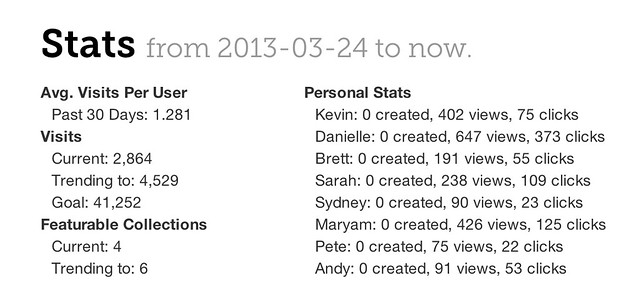
Daily & Monthly Stats
For each metric the graph on the left shows daily stats for all time, and the graph on the the right shows daily stats for the current month (so you can see more detail).
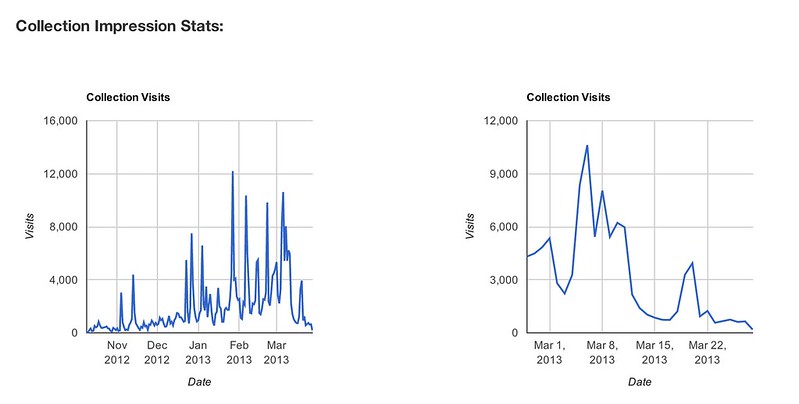
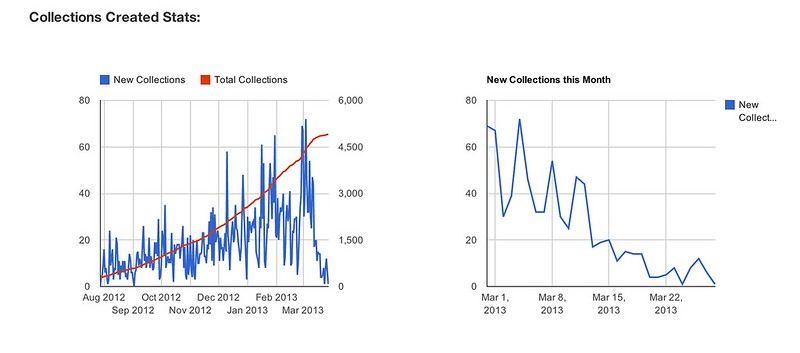
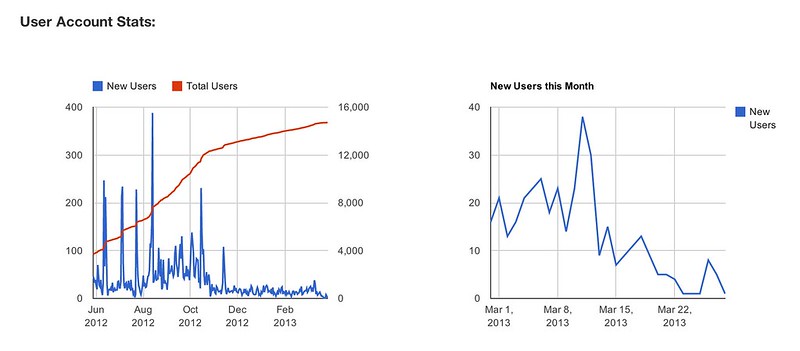
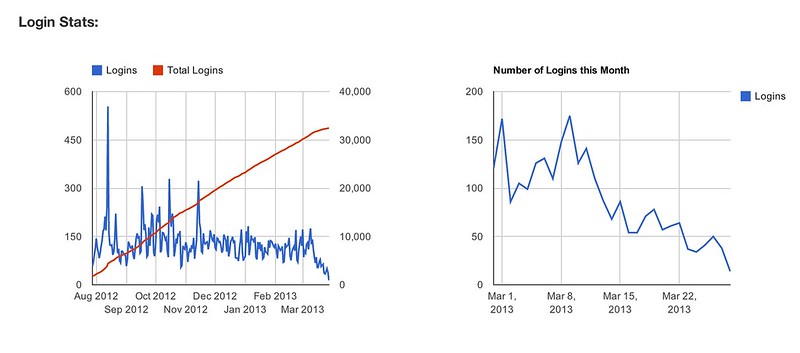


That’s it.
Show Me the Money
You might be wondering why we didn’t share a graph for revenue or gross merchandise sold. This is intentional. I believe that whatever you measure and share is what people will focus on. Having a dashboard for individual revenues earned, or each aggregate revenue, would distract us from our number one priority: creating awesome content people would love reading and sharing. While I tracked this data and shared it with the team periodically it was never the focus of their attention. I set out content generation and traffic goals based on the ultimate revenue goal, but revenue wasn’t something the content team worried about from day-to-day.


Sometimes I wonder whether we would be pivoting now if every person in the company had been focused on maximizing revenue in every piece of content they produced from day one. While I think we might have earned marginally more money in the short term, I think the quality of our content would have been much lower overall and ultimately we wouldn’t have been able to attract the right readership or community of content producers.
To Be Continued…
Over the past year I’ve shared more about Referly than I ever expected to, and I hope seeing these metrics gives you (especially other founders) a sense of what things look like under the covers of a company that is growing, hitting goals and getting PR. Personally, I have learned so much about how to operationalize a technology-enabled media business that consistently puts out content that drives meaningful traffic and keeps people coming back. While we are no longer paying rewards, people from our community of more than 25,000 writers are still logging in and producing new content every day with our awesome edit-in-place CMS. You can absolutely sign up to use Referly as it is today (this link can’t be found on the site, just a little perk for my readers!), and you’ll be among the first to hear what’s next.
—
Do you need to create a business dashboard for your company? This one of my favorite things to do as a company mentor/advisor, and right now I am looking for opportunities to try different approaches and use some of my spreadsheets and other graphing and analytics packages. If you are interested, and willing to pay for my time (in money or beers or coffees) please get in touch at morrilldanielle (at) gmail.
-
Startup Gangnam Style PREVIEW TRAILER
Full length music video COMING SOON!
Gangnam Startup Style Teaser from Fawaz Al-Matrouk on Vimeo.
View more pictures and video stills here
Huge thank you to so many people for helping us make this drunken post Demo Day idea into a reality! From a couple beers and a night of K-pop, to many practice sessions, to a Facebook group of over 350 helpful friends who let us crash a wedding at 111 Minna, film at the original Facebook house, visit the set of the upcoming Bravo reality series on Silicon Valley, and take over the block of a peaceful neighborhood. We salut you, Gangnam style! Oh and sorry Google, we left as soon as security showed up…
Thank you to Fawaz Al-Matrouk who drove up from Los Angeles to do this shoot at the last minute and made it beautiful and high production. We can’t wait to release the final version, but this trailer will give you a few sneak peeks.
-
Scaling Myself
One of things that excites me most about building Referly is that I am able to take figuring out the best method for acquiring customers to a whole new scale. Â Instead of working as the head of marketing for a single company, I can now literally participate in the customer acquisition planning and execution of thousands.
Referly API: Leverage Existing Users with Refer-a-Friend
The most obvious use case for Referly is to set up a refer-a-friend program on a business website and encourage existing users to participate by sharing their customer tracking link with friends.  This is what Love With Food and hundreds of others are doing, and since we launched our API hundreds of businesses have signed up to get our help generating new sales and signups.  Referly helps businesses acquire customers in two ways:
Referly Customer Acquisition as a Service: Pay for Results
When you sign up with Referly you set a reward amount you are willing to pay, usually it gets higher the greater your lifetime customer value is.
While existing users are the best and highest quality referrals you can get, sometimes their referrals just aren’t enough.  This is why we  also work to create campaigns to get you additional customers through paid, SEO, and other methods.  We make money when you get customers, because we try to acquire them for you for less than your bid amount.  That way you never pay more than your bid but you begin to access a whole new base of users.
How We Make Money: Performance
For example, if you bid $2 per new user and we are able to run a Facebook campaign that acquires them for $1.50 each then we keep the $0.50 each time. Â This starts out small but it begins to add up as we learn more about your business and work with you to refine the customer acquisition models and bring higher value customers.
Alternately, some businesses bid so low that we can’t get them customers – but we are able to run experiments and give them that feedback without them risking a lot of money up front.
Marketing of the Future
Referly has just barely scratched the surface of customer acquisition automation and crowdsourcing, but we believe what we are offering will be the distributed sales and marketing department of the future – where millions of small and medium businesses will turn first when it comes to acquiring new customers online. Â Try it and see!
-
Startup Metrics to Obsess Over
I obsess over my startup’s metrics.
I constantly have Google Analytics realtime running in my browser to monitor traffic on Referly, and throughout the day I check it to see how many people are concurrently visiting our website (scroll to bottom to watch video on how to use this tool). I can see how many are new and how many are returning, where they came from and which parts of the site their are viewing, all within a glance. The psychology of this quick data dump into my brain is powerful, either reassuring me that people are discovering us or scaring me into thinking we might live in obscurity forever.
This is one of the worst images a startup founder can imagine (an empty bank account balance is at least an order of magnitude scarier) – and I saw it this morning:
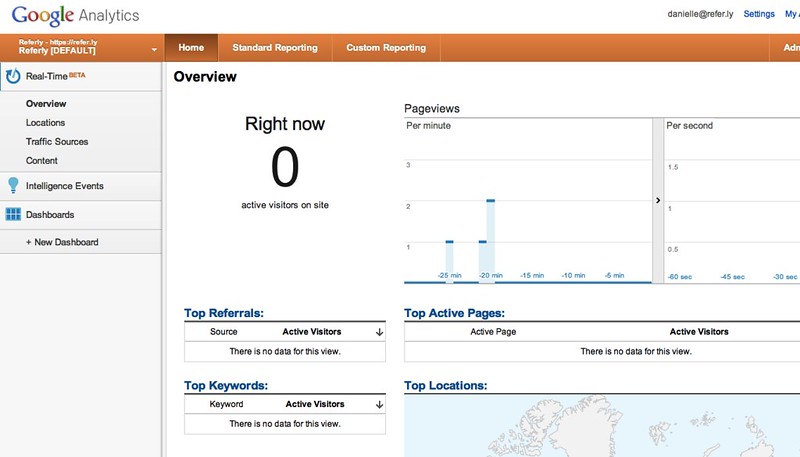
The saving grace here is that it is before 8am Pacific Time as of writing this, so traffic is just beginning to climb. However, that does also indicate that Referly is primarily being adopted by West Coast people in the early-adopter tech community. We are working hard to branch out and reach people all over the U.S. who want to make a little extra income referring products they love. Looking at you New York!
For Google Analytics Realtime, in my head I set a “low water mark” where if the concurrent visitors on the site drops below it I treat it as a red flag (and usually go tweet, blog, etc. to drive more traffic). Â For the past few weeks the low water mark has been 0, and this week I raised it to 1. Â To put this in perspective, just 2 months ago when I was using this practice at my previous company this number was in the hundreds. Â We have a long way to go.
Find Metrics You Can Obsess Over
One great piece of advice from PG, which reminds me of the early days at Twilio, is to find a single metric you can obsess over. For us, it is not web traffic because of the nature of Referly’s business, but for a lot of consumer startups being able to drive traffic successfully is a great place to focus in the early days as you are getting people to kick the tires on the product for the first time and building a word-of-mouth revolution where people are coming back and bringing their friends.
Here’s what our traffic has looked like over the pay 2 months (we launched May 14th):

The Psychology of Looking at Web Traffic
Web traffic can be a dangerous metric to obsess about, because it is fickle. The graph above is smoothed at the monthly level, and on the daily and even weekly levels you can see major peaks (launch announcements, other press) and valleys (nothing interesting has happened for 5 days ahhhH!)
It can also become a vanity metric, because it is something you can buy. Â This is a big reason why I advise companies not to take any paid traffic unless they have very clear mechanics for converting that traffic into actually revenue in a short period of time. Â For businesses with very high lifetime customer value, or high anticipated revenue in the first 90 days of a user registration, you can justify paying for traffic. Â But for social sites, meme generators, news sites, fashion sites, and any other site where the user and her data ARE the product — don’t buy it. Â If you can’t make it organically you don’t have a product yet.
The reason this is so dangerous is that once you buy traffic you will have this graph that you can make go up and to the right on command. Â Simply pump more money in, and the visits numbers will go up — probably as conversion rates go down (if they don’t then keep going!). Â As your team and investors begin to see this graph it sticks in their mind. Â People love to cling to the only scrap of apparent success in an otherwise muddled heap of we-don’t-really-know-yet. Â Beware vanity metrics, Google Adwords can be very difficult to put down once you’ve started.
Graphs That Shape Your Life
I remember attending an art appreciation session years ago lead by Lee Sandstead (OMG I just Googled him and he is Emmy Nominated now! congrats Lee!!!) where he talked about the power art has over our everyday lives. Â Simply by having it on our walls, by looking at it in passing, it shapes our world view.
 The most amazing observation was that it doesn’t even have to be art one likes. Â Take for example the most common piece of artwork found in the Western world, Ave Maria – which is the baby Jesus sitting on the lap of the Virgin Mary. Â Definitely not a piece of art I’m into putting up all over my house (I’m an atheist).
The most amazing observation was that it doesn’t even have to be art one likes. Â Take for example the most common piece of artwork found in the Western world, Ave Maria – which is the baby Jesus sitting on the lap of the Virgin Mary. Â Definitely not a piece of art I’m into putting up all over my house (I’m an atheist).But Lee made this amazing point — it would be better to have this artwork on your walls than nothing. Â If he lived in a world where this was the only artwork allowed (as was the case for hundreds of years) he would welcome it.
It would shape you — you would look at it from time to time and reflect on it. Â It might be simply religious symbolism to you at first, but over time it also might take on other meanings and conjure up other thoughts and memories. Â It would become a point of conversation, maybe with other people, but certainly with yourself. Â It would become a dialogue you returned to over and over again – anything from the mother to son relationship, to asking why he gazes at her but she does not appear to return her gaze to his eyes. Â You might have questions about the halos they wear on their heads, or maybe what she is reading, or why his torso seems so misshapen.
Metrics are the startup version of Ave Maria.
Stick them on the wall, talk about them with each other, reflect on them privately, turn the data this way and that way in your mind trying to understand what it means. Â Forge new connections. Â Place two graphs next to each other which you assume are unrelated and test that assumption.
Metrics You Should Consider Obsessing Over
Here are some other metrics you might consider measuring and understanding. Some of them are more important than others to different kinds of businesses – and what you really want to look for is a single metric that can really tell you whether you are succeeding or failing.
- Visits & %Â Unique Visitors (you could have very high visits because you have the same people coming back over and over again — not a bad thing! Â but important to differentiate from the number of truly unique people)
- Change in your bounce rate over time (are people who come to your site sticking around? Â is it what they expected to see when they clicked through from wherever they were before?)
- Number of times your website is mentioned each day on Twitter
- Number of sites advertising against your website on Google, Facebook, etc.
- % of users who come back more X times
- % of users who come back and perform an action more than X times
- % of users who contribute to revenue
- % of users who have made a “round trip” in your product (completed the GOAL of the product)
- Average number of days (or hours) it takes for a user to go from signed up to achieving the “round trip”
- Signup conversion rate (by day of week, by region, by time on site)
- Email open and click through rates (transactional emails vs. newsletter emails)
Some of these things can’t be tracked with Google Analytics alone, I definitely suggest checking out Pardot and Kissmetrics for more sophisticated event tracking.
There are probably many more, and I’ll keep adding to this list. Â Do you have a startup metric you obsess over? Share it in the comments and help your fellow entrepreneurs.
How to Use Google Analytics Realtime
Great video from Darren Rowe to help you get started
-
Got 99 Competitors and Bit.ly is One
When you launch a company suddenly everyone is a competitor, or so it feels.
Then you realize everyone you thought was a competitor might also be a partner at best, and a distraction at worst. Next you realize your idea is changing so rapidly, fueled by customer feedback and sleepless nights hacking on new features or just eating your own dogfood, that you aren’t totally sure how you fit with anyone anymore.
Today TechCrunch wrote that my company Referly is making gains against Bit.ly after their recent redesign stumble. We saw their launch and it lit the proverbial fire under our butts to ship our next set of features in a fraction of the time, which were somewhat similar to Bit.ly’s. It inspired us to move a lot faster. Creating the artificial constraint of Monday morning, and having a clear competitor, helped us focus and get a lot done while calmly ruling out all kinds of delicious feature creep.
Putting it in Perspective
Its funny, because in some ways we are very similar to Bit.ly and in others quite different — ultimately we are trying to skate to where the puck is going by building the sharing and rewards tools we think people will enjoy using. Just like us, our 99 competitors (or more!) are all trying to create engaging social sharing of products and other links – and this is hard. The battle is not won, and we are focused on becoming as formidably useful as possible.
Unlike a lot of other beautiful social sharing sites out there, we are revealling our business model from day one. You refer stuff, you earn rewards. No shenanigans (Hat tip: Twilio). While in beta we are passing through 100% of commissions to Referly users, but ultimately Referly will need to make money too – and when it comes time to do that we will be straightforward about that, too.
For now, we’re heads down writing code and talking to customers. Stay tuned, and please give Referly a try and let me know what you think in the comments or directly at danielle(at) refer.ly

-
How I Earned $34.91 with Referly
Its been two weeks since we launched Referly to the world, and I’m proud to report that I’ve earned $34.91 using the service to share products I own and love. I’ve tried to act like a (somewhat) normal person with Referly and only share things I’m proud to vouch for, either because they already belong to me or because they were suggested to me by a trusted friend.
At this rate, I’ll earn over $900 in a year – so I’m already thinking about what I want to save up for (and maybe I’ll even build a feature for goals like this into the product!). Maybe a weekend in Napa, or a trip back to Seattle to see my parents. Or maybe I’ll do something much less exciting and just pay down my credit card debt… never know.

Refer Products You Own & Love

It was interesting to see that of all the products I referred, the things I actually owned did much better at earning rewards. In fact, I own every item that generated revenue (see below). I think this is because I can speak about these products credibly, and give them the most meaningful and honest recommendations. I pointed out other stuff I found in passing, like a “cute dress for summer!” or “awesome iPhone case” but I wasn’t speaking with the authority of the owner in those cases, and I think people could tell.
Even better is if you have your own pictures of the product (hello Instragram can we do some biz dev?), or a story about how it was useful or enjoyable to you recently – as I did here in my blog post about how to make my favorite drink the Kir Imperial. Tweets and Facebook statuses are more than ads, they’re the shortest advertorials in the world.
Be Helpful, Not Spammy
Don’t bother sharing hundreds of Referly links in hopes that someone somewhere in your social network will click and buy. That’s just not how it works.  In fact, each time you refer something that people don’t want you lose a little bit of credibility with them, and eventually you run the risk of being called out for being spammy. Good referrers focus on finding recommendations for specific people or groups of people that are actually relevant to them, and helping the recipient of the recommendation understand the reasoning behind the suggestion.
Spammy Example

Helpful Example

Referly doesn’t pay on clicks, so even if you have a huge audience you’ll find that if they don’t take any action on the things you say you aren’t going to get rewarded. You’re better off having a tight network of 100 friends, or 1000 adoring fans, instead of 50,000 Twitter followers who would never ask for your advice in real life.
If Something Works, Keep Sharing It
Referly saves all your links, so you can begin to curate a batch of products that you find useful to share in different situations. For me, the books below are usually right at hand when I am talking to other startup people. The kitchen products are all about my resolution this year to drink more water and work “farmer” hours where I wake up between 6am and 7am (more on that in another post). Both topics come up a lot, and people ask me for my suggestions.
In Case You’re Curious – Here are the Products I Shared
Amazon.com: KOR ONE BPA Free Hydration Vessel http://refer.ly/aa0T
Amazon.com: Bodum 5500-01US Ibis Cordless Electric 57-Ounce Water Kettle, Black http://refer.ly/aabY
The Marketing Playbook: Five Battle-Tested Plays for Capturing and Keeping the Lead in Any Market by John Zagula http://refer.ly/13
Voss, Water Artesian Sprkl, 27.1-Fluid Ounce (12 Pack) http://refer.ly/a0fa
Thomas A Edison Benefactor of Mankind by Trevelyan & Miller Francis http://refer.ly/a09m
Growing Pains: Transitioning from an Entrepreneurship to a Professionally Managed Firm by Eric G. Flamholtz http://refer.ly/t
Amazon.com: Bodum Pavina 12-Ounce Double Wall Thermo Tumbler Glass http://refer.ly/a00V
That’s what I’ve figured out, there is so much more to do. Happy referring!
-
Saying No
I love saying yes. I love helping people, and being generous with my time whenever I can. I love being a mentor. I love the brain dump, having my brain picked and picking others, coffee, chats, happy hour, walks around SOMA, lunch, drinks, late night drives and all the other social activities that I’ve used over the years to build relationships, dispense advice, and make memories and connections.
I love my friends, our regular spots to eat out, drink, brunch, lunch, gossip, bitch, support each other, and hang out.
I love my family, our regular 4th of July drunkeness around their pool, riding the horses, fireworks on the Indian reservation across the street, driving the truck to the dump and smoking a cigar with Dad, the driving range, the “golden hour” and sitting by the burn barrel appreciating the light, walking around the yard in my PJs clipping flowers for the morning table, handmade Irish soda scones.
Focus
Guess what? I’m not going to be doing any of this for awhile – at least for the summer while Referly is in Y Combinator and probably slowly phasing these things back into my life slowly in the next 6 to 12 months after that ends.
I’m going to be saying no to answering long emails, writing long comments on personal blog posts, taking intros to people who want help with developer marketing and developer evangelism, giving career and startup advice, and hundreds of other things. I’m not going to do inbox zero. If it doesn’t relate directly to the metrics I’m driving for the company, I’m not interested.
We both know its nothing personal. I’ll try not to be terse about it. Thanks for understanding.
We’re moving to a house in Mountain View this week, and the team will be living together and cranking for the next 6 months – I’ll miss you SF but its for the best!
(Yes, I am still advising all the companies on my AngelList profile — I have carved out dedicated time for them each month. If you are on that list, do not fear.)
-
Timeline: Starting Referly Took Me Three Years
On Monday we launched Referly, and announced we will be participating in YCombinator this summer. While this is only my second full-time week as a founder, I thought it would be fun to rummage around in my email and Github to grab a timeline of how Referly went from idea to actual company.
As Kim-Mai Cutler of TechCrunch reported, I haven’t been particularly secretive about the idea. I’ve gone through period of active and passive engagement with this idea since October 2009, and got really serious about just this past February.

————————————
April 2009
 Just a few weeks after starting at Twilio I was still working out of Founder’s Fund and coffee shops and living in the Travelodge in the Presidio for $49/night (I hadn’t yet moved to San Francisco from Seattle, and Kevin was still based in Beijing with Microsoft). I met my future Referly cofounder Al Abut for the first time, at the first Startup Weekend in San Francisco. We vowed we would work together someday and stayed in touch.
Just a few weeks after starting at Twilio I was still working out of Founder’s Fund and coffee shops and living in the Travelodge in the Presidio for $49/night (I hadn’t yet moved to San Francisco from Seattle, and Kevin was still based in Beijing with Microsoft). I met my future Referly cofounder Al Abut for the first time, at the first Startup Weekend in San Francisco. We vowed we would work together someday and stayed in touch.October 2009 – Women 2.0 Startup Weekend SF
In October of 2009 San Francisco hosted Women 2.0 Startup Weekend (read my recap blog post of the event). I was invited to join a panel with Dan Martell, Jessica Livingston, Xochi Birch, and Shanna Tellerman. Quite frankly, I was pretty starstruck – these people had built companies, written books, and launched Y Combinator — what had I done to deserve to sit next to them? But I knew what I had done… I had participated in more Startup Weekend events than anyone there.
As panelists our job was to walk the audience of about 150 people through the process of forming an idea, making plans, and answering some questions from the audience. As we convened to figure out what to pitch I threw out an idea that had stuck in my mind for a month or so – affiliate for everyone. We were down to the wire on time, no one else had another idea (and knowing myself I was probably pretty forcefully determined to my idea: Obsession) so we pitched it. The audience had a few questions, but I’d say the reaction was a collective yawn.
We went on to build something completely different on my team, launching Escape My Date and winning the People’s Choice award (Foodspotting was created won the event!) and even getting a little press. I pushed the idea for Referly to the back of my mind.
February 2010 – Leadscon Conference
Went to support our customers and had heard a little about the lead generation industry from the year before (enough to form an idea of it and the idea for Referly) but my eyes were really opened fully for the first time. I was surprised people weren’t doing something similar to Refer.ly and shocked by how little Social Media was part of the conversation for generating business in this channel. It was surprising that it made me wonder if there way some big barrier to entry that I just didn’t know enough to see.
June 2010 – Registered Refer.ly
I signed up for the refer.ly domain name on Libyan Spider:

And another chat that night with a friend from a previous startup, on the idea. Its amazing how little it has changed, and I’m actually surprised to see how confident I was that this was my future company even then!

February 2011 – Shared First Version with Friends
I got the first version of Referly built and shipped to about 50 friends for feedback. In fact, I just found a screenshot of some bug reports from the lovely Liza Sperling, who has been so supportive! This might be the only image I have of the old site. Edit: And yes I do own fuckyeahitscales.com and used to host a lot of my side projects there.

November 2011 – Meeting Alicia at Skimlinks
At first I thought Skimlinks was going to be a huge competitor (I was bummed for about a week, because they are clearly kicking butt and would have been a formidable competitor), but then I realized what I wanted to build was in the consumer space and that they could be a potential partner instead. Meeting her tipped me off — maybe the time was right for this idea.
February 2012 – Refactoring & Redesigning Referly + Alpha Launch
At first I just wanted to reskin Referly using Twitter Bootstrap, but my PHP skills had evolved a lot since I first wrote the app, and reviewing my previous code I found tons of bugs I couldn’t have spotted before. I decided to completely re-write it and move it from my Dreamhost box to its own instance on EC2.
Once it was working, I got good feedback from friends and decided to start talking about it a bit more and to launch to a bigger audience. We added about 500 people through invites at this point. People told me about Gumroad, Pinterest had drama with Skimlinks, and Facebook announced it would re-launch Beacon. The market seemed right.
March 2012 – Applying to YCombinator
I hadn’t really planned to apply to YCombinator when I started coding in February. I felt like I might not be a fit as a solo founder who already had some funding commitments. As the deadline approached I started to fill out the application – at first just on a whim and then more seriously. The morning of the deadline I woke up early and quickly recorded my application video at a friend’s office. I only had time for 30 minutes of practice, then it was just cut it and send it and head off to work.
I also made a ton of last minute edits to my YC application (which I was never very happy with) and sadly I didn’t save the text or I’d share it as well.
April 2012 – Interviewing with & Getting Into YC
I was very surprised to get the invitation to interview. The process of prepping for interviews and interviewing with YC is a total blur to me now, probably because I didn’t sleep much during that time – doing Twilio by day and Referly by night. Byt the time I interviewed I had two employees on board: Alexandra Harris (who I went to middle school and high school with on Bainbridge Island) and Hudson Kelly (who I met while he was visit Silicon Valley with his college class).I am indebted to many YC founders who agreed to meet with me, and gave their brutally honest feedback on the product and pitch. The more skeptical they were, the better they made me – and I’d often fall asleep feeling raw but wake up feeling like I had grown thicker skin and greater wisdom overnight. I met with one every day between submitting my application and going to my interview. I think Referly developed faster in this period than at any other point.
April 2012 – Wrapping Up at Twilio
I love Twilio, and after spending over 3 years there building the marketing team from the ground up to 18 people, I was very passionate about making a solid transition. We brought in two great hires: Lynda Smith from Jive to head things up as our CMO, and James Parton from Telefonica to take the reins in Europe as Director of Marketing in London.
May 2012 – Launch
On Monday, we launched Referly to the world on TechCrunch, AllThingsD, PandoDaily and Geekwire. Next week, the team will be full time and June 1st we move into our house in Mountain View. So in some ways, this is all brand new, but in other ways it is a continuation of something that has been an obsession of mine for quite awhile. I used to think 3 years was forever, but sometime in the last few I’ve learned a bit of patience.
We now are a team of 5, as Kevin Morrill (my husband) agreed to join as cofounder and CTO and Al agreed to join as cofounder heading up all things design. We’ll be moving into our house in Mountain View the first week of June.
Onward!